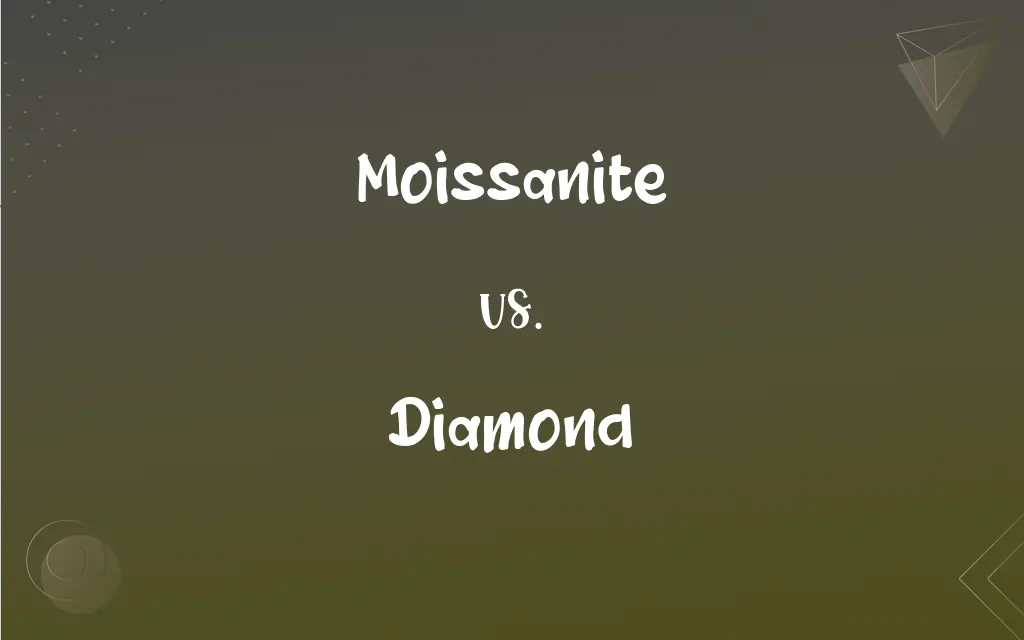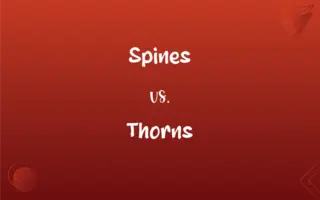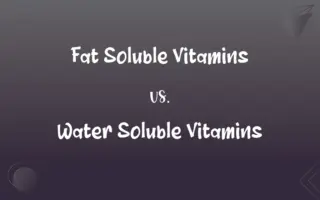Moissanite vs. Diamond: What's the Difference?
Edited by Janet White || By Harlon Moss || Updated on October 23, 2023
Moissanite is a gemstone made of silicon carbide; diamonds are carbon crystals renowned for their hardness and sparkle.

Key Differences
Moissanite and diamond are both cherished for their sparkling appearance in jewelry, but they originate differently. Moissanite is composed of silicon carbide and is naturally rare, often created synthetically for jewelry. In contrast, diamonds are made entirely of carbon atoms arranged in a crystal lattice, making them the hardest known natural material.
Moissanite boasts an impressive refractive index, sometimes even greater than that of a diamond. This means moissanite can exhibit more fiery rainbow colors under certain lighting. Diamonds, however, have a unique brilliance due to their ability to refract white light impeccably. Their shine and luster have made diamonds an iconic symbol of luxury and love for centuries.
Price is another distinguishing factor between moissanite and diamond. Moissanite, being lab-created, typically offers a more affordable price point compared to diamonds, especially when considering larger carat sizes. Diamonds, on the other hand, can command higher prices due to their natural rarity, demand, and the intricate processes involved in mining and grading them.
Durability is a trait where diamonds shine. As the hardest known material, diamonds resist scratching remarkably well, ideal for everyday wear jewelry. Moissanite, while also hard, does not match the unsurpassed scratch resistance of diamonds. That said, moissanite still performs excellently for jewelry use.
Concluding, while both moissanite and diamonds are adored for their beauty, they differ in composition, brilliance, price, and durability. Whether one opts for a moissanite or a diamond usually depends on personal preferences, values, and budget.
ADVERTISEMENT
Comparison Chart
Composition
Made of silicon carbide.
Pure carbon in a crystal lattice.
Refractive Index
Higher, producing more fire.
Lower, but with unique brilliance.
Price
Generally more affordable, especially for larger stones.
Often more expensive due to rarity.
Durability
Hard, but not as scratch-resistant as diamond.
Hardest known material; resists scratches.
Origin
Naturally rare; commonly lab-created for jewelry.
Natural, formed under earth's pressure.
ADVERTISEMENT
Moissanite and Diamond Definitions
Moissanite
A gemstone known for its fiery sparkles.
She admired the moissanite ring for its vibrant rainbow reflections.
Diamond
The hardest known natural material.
Because of its hardness, diamond is used in cutting tools.
Moissanite
Often lab-created for commercial use.
Most moissanite in jewelry stores is synthetic, crafted meticulously in labs.
Diamond
Often graded based on cut, clarity, color, and carat.
The diamond's clarity and cut determined its brilliance and value.
Moissanite
A popular diamond alternative in jewelry.
For their anniversary, he chose moissanite due to its beauty and affordability.
Diamond
Conducts heat well and is typically transparent.
A diamond's ability to dissipate heat makes it unique among gemstones.
Moissanite
A rare mineral composed of silicon carbide.
The discovery of moissanite dates back to a crater created by a meteorite.
Diamond
Symbolic of luxury, love, and commitment.
He proposed with a diamond ring, signifying their everlasting bond.
Moissanite
A stone with high heat conductivity.
The jeweler tested the moissanite and was impressed by its heat resistance.
Diamond
A precious gemstone formed from carbon under extreme pressure.
The diamond's unmatched hardness makes it invaluable in various industries.
Moissanite
(mineral) Naturally-occurring silicon carbide, having various crystalline polymorphs.
Diamond
An extremely hard, highly refractive crystalline form of carbon that is usually colorless and is used as a gemstone and in abrasives, cutting tools, and other applications.
FAQs
Is moissanite more brilliant than diamond?
Moissanite can exhibit more fire, but diamonds have a unique brilliance of their own.
Why are diamonds more expensive than moissanites?
Diamonds are often pricier due to natural rarity, mining costs, and high demand.
Can moissanite be differentiated from diamond easily?
Professionals can differentiate using specific tests, but to an untrained eye, they may appear similar.
Why is moissanite considered eco-friendly?
Since most are lab-created, their production has less environmental impact than diamond mining.
How was moissanite first discovered?
It was discovered in 1893 in a meteor crater by Henri Moissan.
Which is rarer in nature, moissanite or diamond?
Moissanite is rarer in nature compared to diamond.
Are most commercial moissanites natural or lab-created?
Most are lab-created due to the rarity of natural moissanite.
Can both moissanite and diamond be used in engagement rings?
Yes, both are popular choices, depending on personal preferences and budget.
Can moissanite scratch easily?
Moissanite is hard and resistant to scratches, though not as much as diamond.
Is moissanite a modern discovery?
While discovered in the late 19th century, its use in jewelry is relatively modern.
Which gemstone is more durable for everyday wear?
Diamond, being the hardest material, offers superior durability.
How are diamonds formed naturally?
They form under high pressure and temperature conditions deep within the Earth.
Are there different grades of moissanite?
Yes, like diamonds, moissanites have grades based on clarity and color.
How are synthetic moissanites created?
They're grown in labs using advanced technology to replicate natural conditions.
Why are diamonds symbolic of commitment and luxury?
Their rarity, brilliance, and historical significance contribute to this symbolism.
What are the "4 Cs" related to diamonds?
Cut, Color, Clarity, and Carat.
Why do some diamonds have colors?
Presence of impurities or structural defects can give diamonds color.
Are there ethical concerns related to diamond mining?
Yes, concerns include environmental damage and "blood diamonds" linked to conflict.
Is the market for moissanite growing?
Yes, it's gaining popularity as an affordable, beautiful alternative to diamonds.
Can diamonds be created in labs?
Yes, lab-grown diamonds are now available and share properties with natural diamonds.
About Author
Written by
Harlon MossHarlon is a seasoned quality moderator and accomplished content writer for Difference Wiki. An alumnus of the prestigious University of California, he earned his degree in Computer Science. Leveraging his academic background, Harlon brings a meticulous and informed perspective to his work, ensuring content accuracy and excellence.
Edited by
Janet WhiteJanet White has been an esteemed writer and blogger for Difference Wiki. Holding a Master's degree in Science and Medical Journalism from the prestigious Boston University, she has consistently demonstrated her expertise and passion for her field. When she's not immersed in her work, Janet relishes her time exercising, delving into a good book, and cherishing moments with friends and family.































































